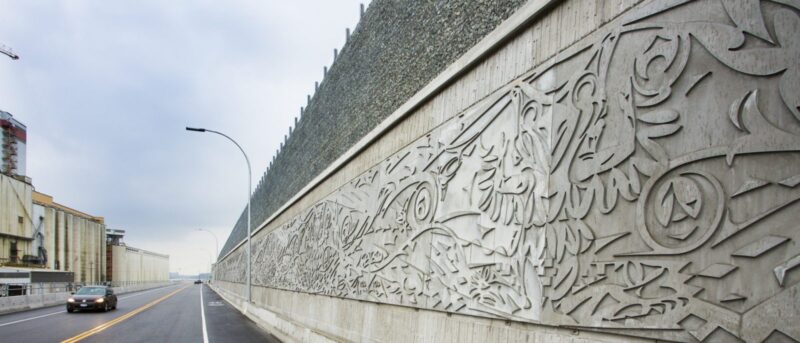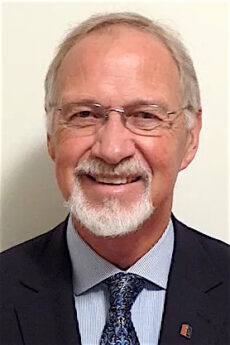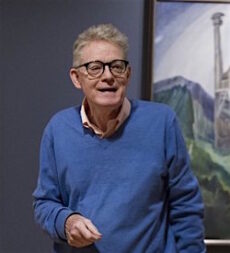1039 Outward from Musqueam
People Among the People: The Public Art of Susan Point
by Robert D. Watt
Vancouver: Vancouver: Figure 1 Publishing in collaboration with UBC Museum of Anthropology, 2019
$50.00 / 9781773270425
*
Susan Point: Spindle Whorl
by Grant Arnold and Ian Thom (editors), with a foreword by Kathleen Bartels
Vancouver: Vancouver Art Gallery and London: Black Dog Press, 2017
£24.95 / 9781911164265
Both books reviewed by Megan A. Smetzer
*


On February 11, 2020, the French Government awarded Musqueam artist Susan Point the insignia of Chevalier dans l’Ordre des Arts and des Lettres (Knight in the Order of Arts and Letters), the latest in a long line of awards acknowledging her exceptional career. As the first Indigenous person to ever gain this recognition, the award affirms Point’s renown as a ground breaker and glass ceiling shatterer throughout her nearly four decades of artistic production. Two recent publications: Robert D. Watt’s 2019 People Among the People: The Public Art of Susan Point and The Vancouver Art Gallery’s 2017 exhibition catalogue Susan Point: Spindle Whorl contextualize her rich body of work from intersecting yet unique perspectives. The former, intended as a tribute, visually documents and describes Point’s publicly accessible works situated in British Columbia, the Pacific Northwest, and beyond. The latter, intended as survey, balances personal reflections and scholarly essays with beautiful photographs of Point’s spindle whorls in diverse media.
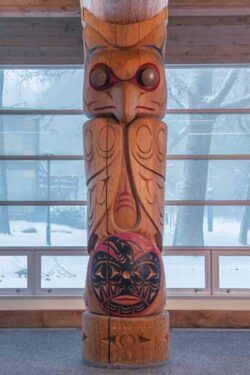
Both texts embrace the physical and metaphorical circularity embodied by the spindle whorl, an ancient carved form imbued with spiritual power used in the creation of woollen yarn for weaving. In her discussion of Raven with Spindle Whorl, the house post she carved in 1993 for the First Nations House of Learning at the University of British Columbia, Point explains the significance of the form. “The purpose for my having incorporated the spindle whorl is because it has been a key element in my quest to revive Coast Salish art and in so doing making everyone aware of this beautiful and almost lost art form” (People Among the People, p. 33). Susan Point includes a brief essay by the late Museum of Anthropology curator, Bill McLennan, that introduces historical and spiritual understandings of the spindle whorl and its use, providing additional context to Point’s own perspectives.
People Among the People is structured geographically to circle outward from Musqueam, expanding slowly but surely to encompass the entire region within which the majority of Point’s public artworks exist. Robert Watts, former director of the Museum of Vancouver notes: “It is an arrangement that emphasizes the deep roots of Susan’s creative spirit, her debt to family, Elders, and ancestors, and her success in taking Salish forms and reshaping them in her own way to re-establish a Salish footprint in the ancestral lands of her people…” (p. 27). This clever framework foregrounds the cyclical aspects of Musqueam worldviews. At the same time, the format creates a somewhat distracting repetition within the descriptions of individual works as it travels back and forth in time, often covering similar ground in terms of inspiration or execution of the work.
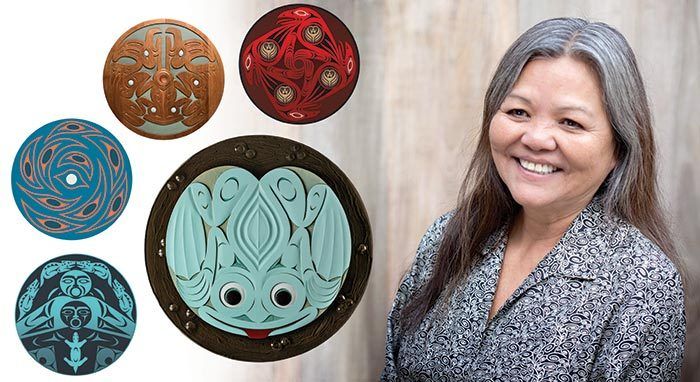

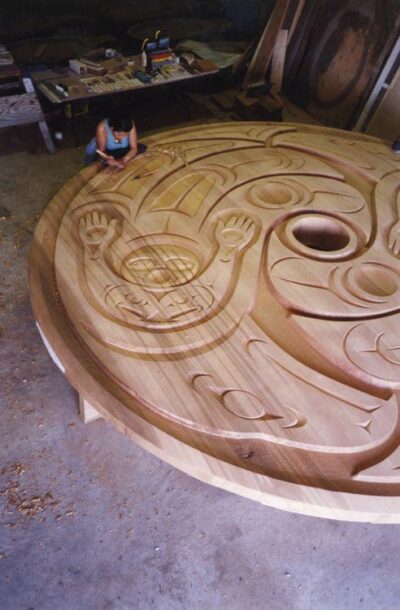
The Vancouver Art Gallery’s focus on the eponymous form, while visually cohesive, perhaps unintentionally minimizes the expansiveness of Point’s long career. Kathleen S. Bartel, recently retired Director of the VAG, argues that emphasis on this form “is a tribute to Point’s extraordinary skill and imagination that, far from restricting our appreciation of her work…serves to emphasize the depth and power of her contributions to the visual history of both Coast Salish and Canadian Art” (p. 7). An essay by Kathryn Bunn-Marcuse, Curator of Northwest Native Art at the Burke Museum in Seattle, counters the reductiveness of this focus. In “Susan Point: Primacy and Perspective” Bunn-Marcuse explores Point’s printmaking and public art to examine themes within her evolving practice over several decades as well as her significant impact and influence on the revitalization of Coast Salish art. Read together, the two volumes provide a comprehensive overview of Point’s vast body of work.
One of the strengths shared by both volumes is an emphasis on Susan Point’s own words in terms of descriptions of individual works, their inspiration, and the process of their creation. Spindle Whorl also includes an essay by Point, “Tribute to My Friend Bud Mintz” that discusses her early career and the support she received to develop artwork for the Northwest Coast market utilizing coast Salish style. Point’s reminiscences, in combination with other statements made in passing, illuminates the expansion of the market for Northwest Coast arts since Point’s earliest participation in the 1980s. At that time, the market was heavily skewed toward northern male carvers. Point was an innovator in terms of her gender, her experimentation with diverse media, as well as her focus on Coast Salish design. Even after nearly four decades in the field, Point continues to break new ground as Bartels notes, “Susan Point: Spindle Whorl is the first comprehensive exhibition by a Coast Salish artist to be presented at the Gallery” (p. 7).
Though Point’s work is rarely as overtly political as that created by some of her contemporaries – notably Lawrence Paul Yuxweluptun or Michael Nicoll Yaagulanaas – both volumes include works and words by Point that indicate her longstanding engagement with local environmental concerns as well as the intergenerational impact of residential schools on Indigenous peoples and communities. As Bunn-Marcuse notes, many of her more recent works reference “the sovereignty of land tenure and cultural practice” (Spindle Whorl, p. 65). Point returns again and again to beautifully rendered, yet subtle environmental themes.
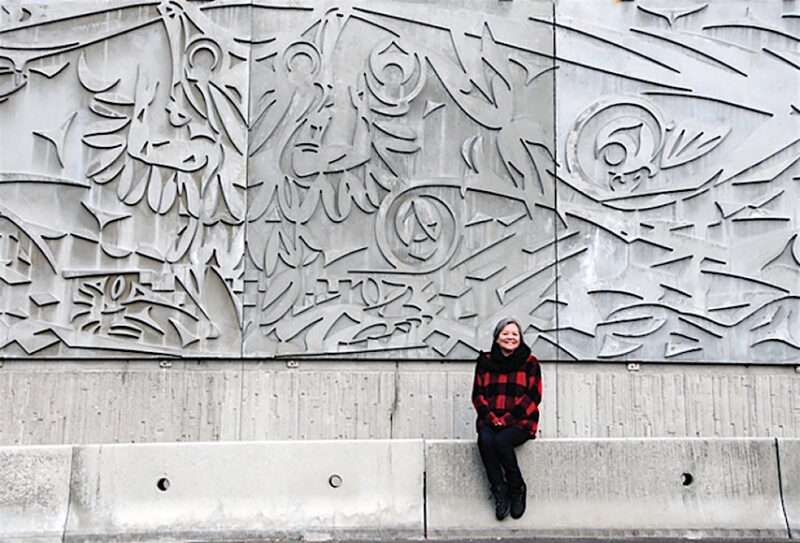
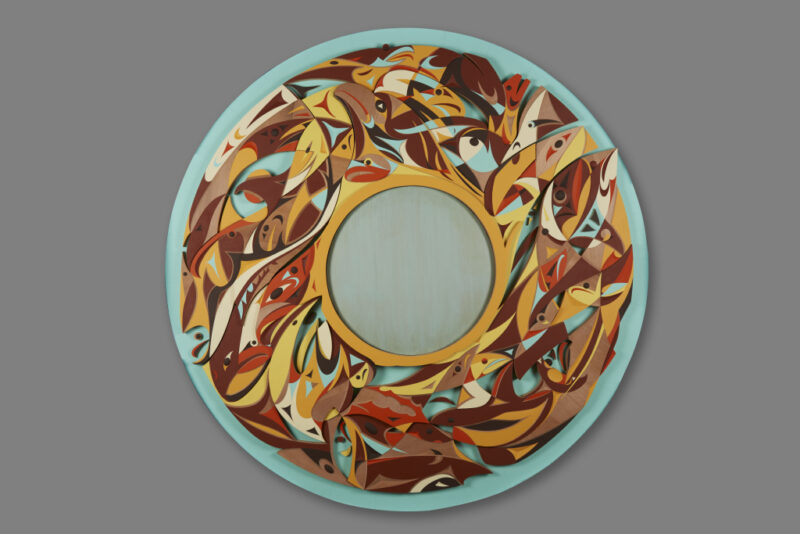
Beyond the Edge (2015), for example, draws on respected environmentalist David Suzuki’s concept of the thin blue line that represents earth’s atmosphere to foreground the delicate balance of life on our planet. “Within the zone of our thin biosphere, life thrives and evolves. We humans are part of a web of interconnections closely linked to one another” (p. 114). These interconnections are represented through intertwined and overlapping animal forms defined primarily in a range of earthy tones contained within a blue-green circular frame. Both volumes include versions of this work as well as Point’s full quote describing her inspiration. People Among the People also includes a discussion of the initial commission by the Portland Art Museum as well as the process of the work’s fabrication. This depth of contextual information is typical for each public artwork included in this book.
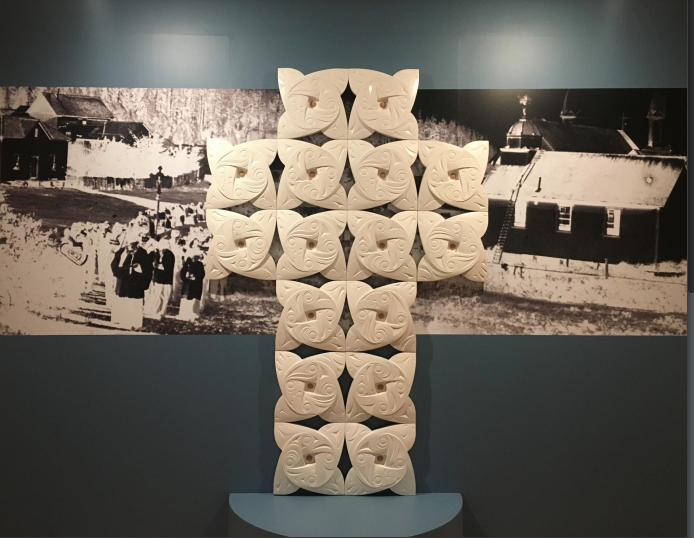
Perhaps one of the most overt political statements included in either volume is Butterfly Grid (2016), Point’s engagement with the shameful history of residential schools in Canada. The stark white work consists of a series of circular motifs created from “fragments of butterfly wings” arranged in the shape of a cross. Point notes that the piece serves both to represent “the disconnection from the wisdom and teachings I lost as a young child as well as our Hunquemi’nem language” as well as “a symbol of power for those of us who had strength and resilience and survived the residential school system” (p. 130). Even when addressing difficult issues, Point’s meticulous attention to detail and design, as well as her embrace of a broad palette of colour and diverse media showcases the resilience noted in her statement.
Both volumes make clear that Point has long been a critical path breaker. Indigenous women’s artistic practices, particularly along the Northwest Coast, have only now begun to receive the same sustained attention as that of their northern male counterparts.[1] These two richly illustrated volumes, though geared toward a general readership, are a welcome and needed addition to the hard work being done to address gender inequity both within the literature of the region, and beyond.
*
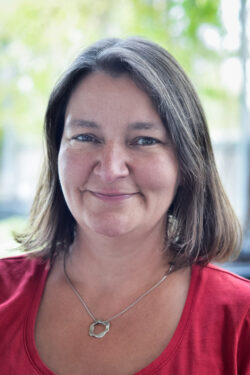
Megan A. Smetzer, PhD is an independent art historian living and working in Vancouver on the traditional and unceded territory of the Musqueam, Squamish and Tsleil-Waututh peoples. In addition to teaching art history at Capilano University, she publishes and lectures primarily on historical and contemporary Northwest Coast Indigenous art, focusing on the cultural expressions of women. Her most recent essay about Tlingit weaver Shgen Doo Tan George appears in Unsettling Native Art Histories on the Northwest Coast (2020). Her book, Painful Beauty: Tlingit Women, Beadwork, and the Art of Resilience will be released by the University of Washington Press in July 2021. Editor’s note: In April 2017, Megan Smetzer reviewed an exhibit, Ellen Neel: The First Woman Totem Pole Carver, for The Ormsby Review.
*
The Ormsby Review. More Books. More Reviews. More Often.
Publisher and Editor: Richard Mackie
The Ormsby Review is a journal service for in-depth coverage of B.C. books and authors. The Advisory Board consists of Jean Barman, Robin Fisher, Cole Harris, Wade Davis, Hugh Johnston, Patricia Roy, David Stouck, and Graeme Wynn. Scholarly Patron: SFU Graduate Liberal Studies. Honorary Patron: Yosef Wosk. Provincial Government Patron since September 2018: Creative BC
“Only connect.” – E.M. Forster
Endnotes:
[1] See for example: Kathryn Bunn-Marcuse and Megan A. Smetzer. “Working to Change the Tide: Women Artists on the Northwest Coast.” In Hearts of Our People: Native Women Artists, edited by Jill Ahlberg Yohe and Teri Greeves, 258–72. Minneapolis Institute of Arts in association with Seattle: University of Washington Press, 2019; also, Kathryn Bunn-Marcuse and Aldona Jonaitis, eds. Unsettling Native Art Histories on the Northwest Coast. Seattle: University of Washington Press, 2020, which includes several essays featuring women artists.
